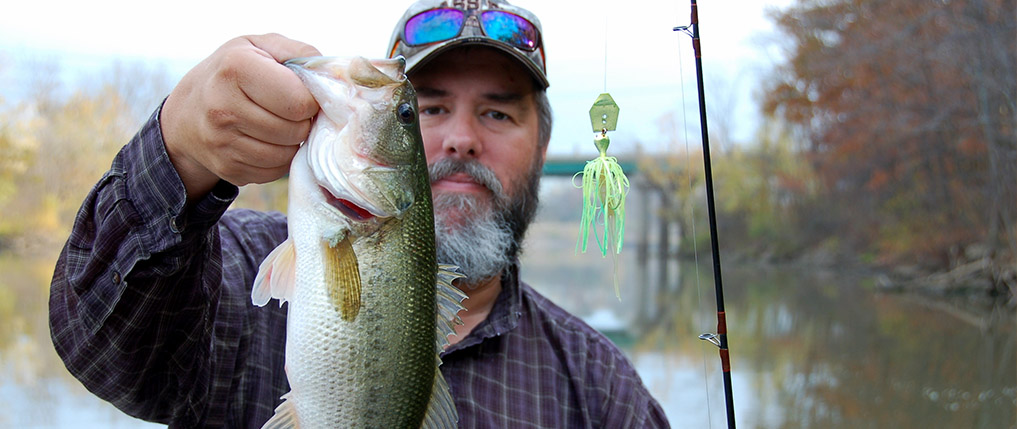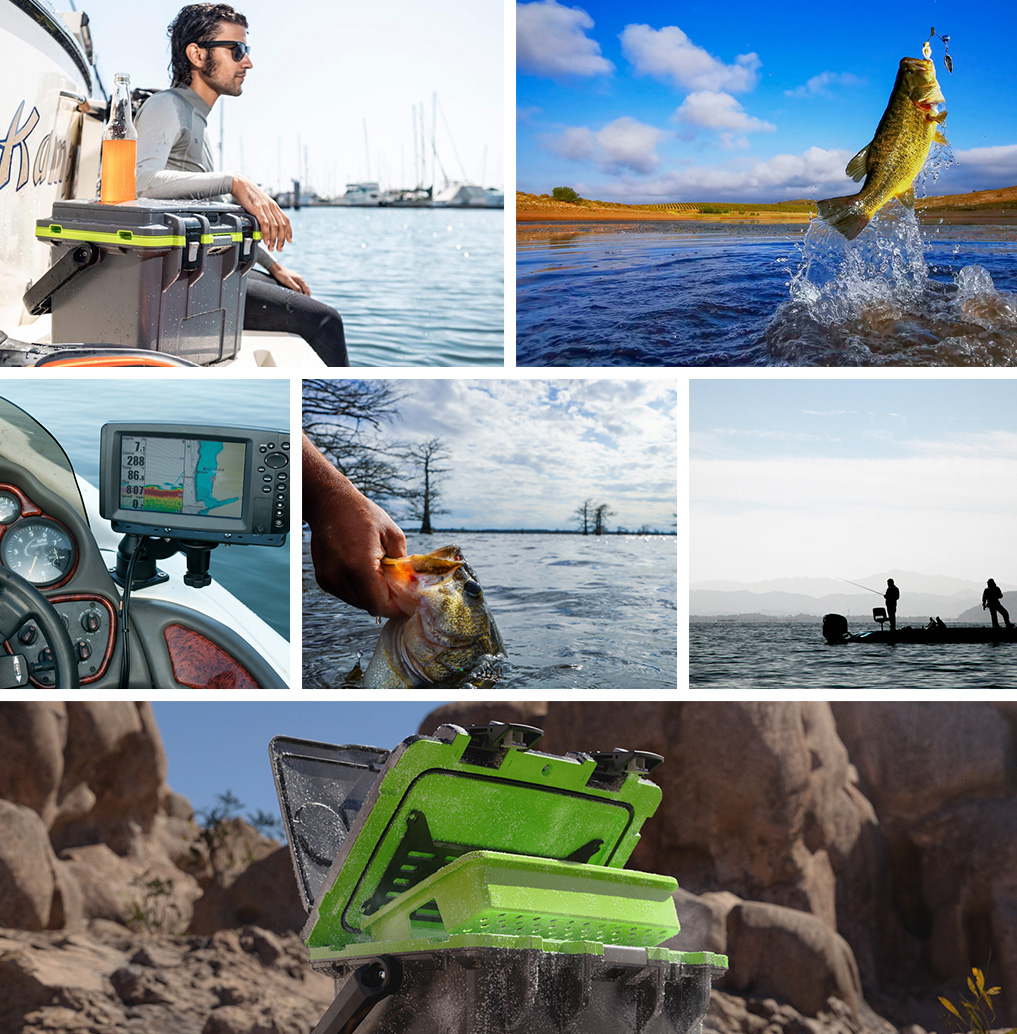The Best Time to Fish for Bass
December 13, 2021

Ready to catch some bass? You have the right lures and know a good fishing hole, but when precisely should you carve out some time?
Bass, like many fish, have their own habits, feeding and spawning during certain hours of the day and seasons within the year. So, just when should you plan to hitch the boat up and head to the lake? Spring, summer, fall or winter? Here’s the best time to fish for bass!
The Best Time to Fish for Bass
Generally speaking, the best time to fish for bass is at dawn and dusk. Catching bass requires you to wake up early in the morning and to stay out later in the evening. Why is this? Because bass like to hunt and feed in low-light environments. Before the sun rises high in the sky, bass can hunt better. Alternatively, you can also catch bass midday if it’s overcast and rainy, too.
When it comes to the best season to fish for bass, spring and summer are good times. Ideally, it’s when the water temperatures range from 60 to 80 degrees. However, many anglers will also tell you that it’s in spring whenever bass begin to spawn. When bass begin to spawn, they feed heavily to fatten up so they have energy for reproduction. During their feeding times, the bass get more active, jumpy and aggressive, which means they will take the bait more readily.

Some anglers say the best time to fish for bass is mid-summer when bass feeding is at its highest. During this time, bass tend to settle between both deep and shallow waters, reaching deeper on sweltering hot days.
The Best Time to Fish for Bass – Daily!
In a 24-hour day, what’s the best time to fish for bass? As mentioned, dusk and dawn are excellent times to catch the big one. And here’s why:
Early Morning/Dawn
From roughly 5:30 to 8:30 a.m., the bass are hunting in the low light. In general, they will be looking for minnows and shiners, which makes them enticed by artificial shoreline lures, plugs and topwater poppers. While your “dawn” might change based on the season and daylight saving time, the concept is still the same. So pack breakfast in your personal cooler and head to the water with your coffee. The bass are biting!

Late Afternoon/Dusk
During the 5 to 7:30 p.m. time frame, you’ll get the bass-biting low light again. In the late afternoon dusk, bass will find topwater lures enticing. However, if the weather is chilly, the bass might get a bit lazy. When this happens, head toward deeper waters! Depending on the area you’re fishing, the bass sometimes react to different speeds. Test out a few different retrieval speeds to see what attracts the local bass.
Nighttime Hours
Without other anglers around, night fishing can be an optimal time to fish for bass. Bass need low light to see and hunt. However, if you choose a night with a full moon, it can be just enough of a glow to lure them out. Otherwise, if the night is pitch dark and cold, you will have little luck.
Fishing at night requires a few more tricks up your sleeve. Bass can get pretty lazy when it comes to hunting in the dark. If they can’t see prey well, they won’t even attempt it. Still, they are attracted to noise, which is why large lures like spinners and buzz-bait come in handy, allowing the bass to feel them in the dark waters.
It’s worth noting, too, that an LED headlamp comes in useful for night fishing. A headlamp offers a hands-free device so you can work with your hands to reel in the bass or pick out a lure.
When’s the best time to fish for bass by season? Whether it’s summer or winter bass fishing, let’s take a look at when they’re seasonally biting.
Winter Bass Fishing
temperatures start to rise, so do the bass. However, it’s only once the water reaches at least 40 degrees or so when you’ll have a greater chance of catching them.

When winter bass fishing, be aware of steadily rising water heating patterns. Look for water temps that gradually increase, as opposed to dramatic fluctuations. For example, if you have a week of water temps that rise from 38 to 40 to 42 by Sunday, it’s a good time to grab the pole and hit the water. Female bass especially enjoy this gradual warmth in water, showing lots of activity. And remember: The best time of day to catch bass in the winter is during the middle of the day when temperatures are highest.
Spring Bass Fishing
Once the winter season thaws and temperatures begin to rise, all types of fish will come out from their hibernation, so to speak, and return closer to the surface. Spring rains bring warmer water and bass love it! However, the early spring season can be unpredictable. One day it could be warm and sunny, and the next could call for freezing nighttime temps with rain.
Overall, in spring, keep an eye on the weather and still look out for cold fronts. Cold fronts can drive fish back to their deeper underwater dwellings. It gets trickier, but not impossible. Lure bass out from shallow coves and peninsula-like pointed banks with chatterbaits, spinnerbaits and good old-fashioned worms.
Later in spring, when the rain lets up and temperatures calm to something relatively average, bass will come out in preparation for the spawning season. Head out for some fishing on a day the water temps reach somewhere between 55 and 65 degrees Fahrenheit. Go at dawn in the early morning or at dusk and use large lures to attract your bass.
Summer Bass Fishing
In summer, when spawning comes to an end, bass will need to renourish themselves and feed. This is when the bass is most active, searching for food in both shallow and deep waters. However, the hotter the day, the deeper they will go. Almost any type of bait or lure will attract a hungry, eager bass in summer. Use topwater baits, worms, jibs or whatever you have stored away in the tackle box. Just close your eyes and grab something out. If you do go out in the summer, make sure to keep your catch fresh. Keep a fishing cooler on the boat so your dinner makes it home.
Fall Bass Fishing
Fall might slow down the bass a bit, but it’s still a great time to get a big catch. Before heading deeper into the waters for winter, bass will have one more major feast on baitfish, such as shads and shiners. And this means you should stick to lures like spinnerbaits, swimbaits, jerkbaits and crankbaits to attract them. Spinnerbaits and swimbaits work incredibly well on a windy fall day. In the fall, striped bass is easy to come by during peak or slack tide.

Spawning Season
As you might imagine, bass focus on protecting their nest during spawning season, which presents quite a challenge for anglers. Again, not impossible, just tricky. The best way to catch bass during spawning season is to place your bait in the middle of the nest to disturb the female bass. Often, if they leave, they can be found hiding in deeper waters.
Spawning season is hard to determine. However, there are a few tried-and-true ways of keeping track. For instance, many anglers find that the spawning season underwater aligns with certain natural events on land, which we can see easier. In the South, bass spawning season tends to start when the dogwood trees begin to bloom. But if you live in a region where dogwoods are scarce, you can also go by dandelions. When dandelions start to produce big fluffy heads of seeds, that’s a good indication bass are spawning.
The Best Time to Fish for Bass Species
Now that we’ve gone over the time of day and the season to fish for bass, let’s explore how to fish for specific species. Whether it’s largemouth bass, striped bass or smallmouth bass, each fish has their own unique traits and hiding spots. Knowing how to lure them out, even if it changes slightly, can give you a real advantage.
Largemouth Bass
Largemouth bass can often be found in deep waters, but near the water’s edge. For example, at the end of a long pier over deep waters or near a sharp bank or cliff, which you can assume goes pretty deep beneath, too. Largemouth bass can be found anywhere from two to 12 feet deep, especially in spring when temperatures are warming up. Also, be sure to check out the lake’s northwest corners, as this area can get a bit warmer. If you can spot spawning flats from the boat, this is an excellent place to fish for largemouth bass, too.

Largemouth bass are pretty predictable when it comes to seasons. However, there are still some tricks you need to know. Largemouth bass tend to use low-light conditions to hunt for prey, which points to the dawn and dusk time frame mentioned earlier. One interesting trait of largemouth bass: They will strike bait even when they’re not hungry. Sometimes, provoking them with a bait or lure is all it takes.
Overall, when it comes to largemouth bass, the best time to fish surrounds their spawn period. From pre-spawning to post-spawning, bass are highly active, feeding on everything in sight – including your bait!
Striped Bass
Striped bass have an annual migration run time around the spring and fall. Since striped bass desire water temperatures in the 55- to 68-degree range, they keep moving, seeking out these temperatures as needed. During both the spring and fall migrations, anglers will find the best striper fishing. However, the fall run offers a rewarding challenge.
Smallmouth Bass
As the name implies, smallmouth bass have smaller mouths than the largemouth bass. However, don’t let their small bite fool you. Smallmouth bass have quite the attitude and a fierce strike. If you’re looking to catch this ornery bass species, head out on the water during the wee dawn hours and three hours before dusk.
Smallmouth bass can be found all across the states and caught in every season, although summer is when they are most active. In the summer, smallmouth bass have an increased metabolism, which means they need to eat more frequently.
Smallmouth do enjoy living in deeper 20- to 30-foot waters. With a sharp vision, smallmouth bass use similar predatory moves as the largemouth bass, so the same lures and bait should do just fine. Find waters at just the right temperature with a bit of shade from trees or an overcast day and you are sure to catch a bounty.
Ready to Catch Some Bass?
With these tips and tricks, catching bass should become a heck of a lot easier! However, if you find yourself out of luck, try changing your approach by shifting the time of day you fish or the season. Remember to seek out shaded areas where bass shelter on a hot summer day and try fishing on a cloudy day, too. If night fishing with a buddy sounds like fun, do it!
Above all, take in the scenery. Enjoy the sounds of the lake and simply appreciate being out on the water. Fishing takes patience, but that’s part of its allure. Make the most of your day and if you come home with a fish or two, even better.

SIGN UP FOR EXCLUSIVE OFFERS
Sign up for our newsletter and get exclusive access to new product launches, special offers and much more.
RELATED BLOGS














